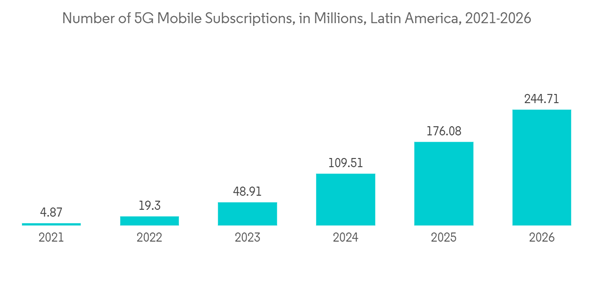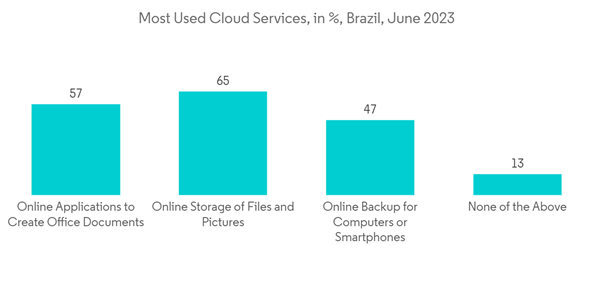Key Highlights
- Countries such as Brazil have seen recent improvements in fixed broadband latency as demand for digital activity rises during the Covid-19 outbreak. In Argentina, the development of content delivery network (CDN) data centers is reflecting a positive trend. Overall, the market for data center networking reflects an upward trend in the region.
- The upcoming IT load capacity of the South American data center construction market is expected to reach 1800 MW by 2029. The region's construction of raised floor area is expected to increase 7.8 million sq. ft by 2029.
- The region's total number of racks to be installed is expected to reach 392K units by 2029. Brazil is expected to house the maximum number of racks by 2029.
- There are close to 60 submarine cable systems connecting South America, and many are under construction. One such submarine cable that is estimated to start service in 2025 is Carnival Submarine Network-1 (CSN-1), which stretches over 4500 Kilometers with a landing point in Barranquilla, Colombia.
South America Data Center Networking Market Trends
IT and Telecom to Hold Significant Share
- Over the past decade, South America has made huge strides in terms of developing infrastructures, although the status of its digital ecosystem varies. Although the general penetration of fixed broadband is low, significant efforts are now being made in different countries across the region to deploy fiber optic networks.
- The Chilean government has substantially invested in fiber-optic networks, with connections now reaching more than 90% of the population. Due to this, the majority of Chilean families now have access to high-speed internet services, enabling them to benefit from the expanding range of available digital services.
- In terms of 5G connectivity, all municipalities with at least 200,000 residents in Brazil will have a 5G network by July 31, 2026, with at least one antenna. Brazil's 5G spectrum auction held in October 2021 raised about USD 8.5 billion. By 2035, introducing 5G in Brazil may have a USD 1.2 trillion economic impact and a USD 3 trillion productivity boost. Overall, with increasing network traffic, the data center construction is increasing, leading to demand for major networking solutions.
- In October 2021, UPIX Networks, a facility-based supplier of last-mile fiber in Brazil with a platform for global connectivity network services, extended its optical fiber network into NJFX, the only Carrier Neutral Cable Landing Station (CLS) colocation campus in the United States having Tier 3 capabilities. This provides carriers and companies with mission-critical applications such as financial services, healthcare, and OTTs with additional high-performance connectivity alternatives.
- UPIX offers considerable network resources in LATAM, including last-mile capabilities throughout Brazil, and has twin headquarters in Brazil and the United States for improved agility. This provides a distinct competitive advantage and allows NJFX customers to reach a wider audience. In addition, the company provides onramps to strategic cloud partners such as AWS, Oracle Cloud, Google Cloud, Microsoft Azure, and Alibaba Cloud.
- Companies in the Mexican region are actively developing new products to gain access to local networks, which is expected to fuel the growth of the Ethernet controller market in the region. In March 2022, Arelion announced the addition of two new points of presence (PoPs) to its network in Mexico, bolstering the ecosystem in Mexico City (CDMX). This collaboration enables local access to Arelion's top-ranked global backbone, AS1299, in the MEX|5 and MEX|2 Data Centers managed by KIO Networks, bringing Arelion's total PoPs in Mexico to six.
- Businesses in Mexico City can now leverage Arelion's globally recognized backbone, AS1299, along with local access to high-speed IP Transit, Cloud Connect, DDoS Mitigation, Ethernet, and IPX services. These services are designed to meet the needs of operators, content providers, and corporations. The growth in network infrastructure in South America is expected to drive market demand throughout the forecast period.
Brazil to Hold Significant Growth
- Brazil's digital economy demonstrates the potential for continued growth over the medium and long term. The Brazilian government plays a significant role in developing local data center infrastructure. According to the government, the country's General Data Protection Act (LGPD) was implemented in August 2020. It is now expected to force many enterprises to migrate their cloud access to private networks and update their encryption services to extend user data protection.
- As per TI Inside, in the first quarter of 2020, the network switch sales revenue in Brazil stood at USD 67.3 million, a potential increase of USD 5.9 million from the 2019 first quarter. The COVID era stood for more demand due to the major adoption of digital platforms.
- Currently, about 10-15% of data is created and processed outside a centralized data center or cloud, but the number is expected to cross 60-70% by 2025, a global trend that is also expected in Brazil. Such factors will lead to major networking infrastructure demand in terms of ethernet switches, routers, and others.
- Latin American cloud service providers are increasingly pressured to offer a unique and differentiating user experience for applications. At the same time, they need to become more efficient and reduce costs as much as possible to deviate traffic away from the regular web servers and introduce container technology that launches specific services of the ADC system.
- In Brazil, Microsoft, Amazon Web Services, and Google are the major cloud service providers. These cloud service providers will collocate their workloads with existing colocation operators and collaborate with new entrants entering the market to provide cloud-based services. In March 2021, Microsoft announced new availability zones in São Paulo as part of its 'More Brazil' plan. In addition, the company has planned to expand its zone coverage by the end of 2021. Application delivery controllers can benefit from the advantages of the acceptance of cloud applications in Brazil, thereby impacting the market growth positively,
- In terms of data center construction, in May 2023, Brazilian telecom operator Megatelecom announced that they are planning to deploy dozens of Edge data centers across the country and expand its fiber backbone by 2028. To develop the edge-fiber network, Megatelecom is partnering with Union Sistemas e Energia. Such development is expected to cater to major market demand.
South America Data Center Networking Industry Overview
The South American data center networking market is characterized by fragmentation among various players, and it has witnessed a surge in competitiveness in recent years. Key industry participants include NEC Corporation, Juniper Networks Inc., and VMware Inc., among others. These major players, boasting substantial market share, have been actively focused on expanding their customer base within the region. To achieve this, they employ strategic collaboration initiatives aimed at augmenting both market share and profitability.In January 2022, TP-Link Corporation Ltd. made an important announcement with the launch of the Archer AXE75, an AXE5400 Tri-Band Gigabit Wi-Fi 6E router. This innovative router is designed to provide a wide range of high-performance features and is complemented by the HomeShield security system. It is equipped with a robust chipset, further enhancing its capabilities in the competitive market landscape.
Additional Benefits:
- The market estimate (ME) sheet in Excel format
- 3 months of analyst support
This product will be delivered within 2 business days.










